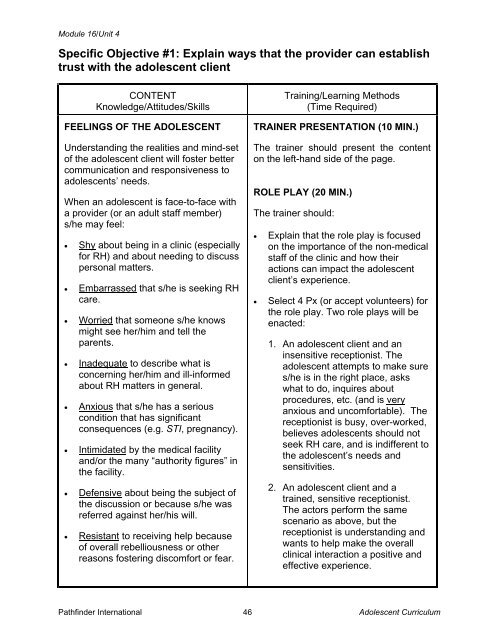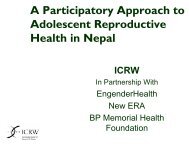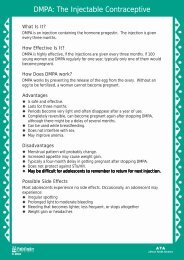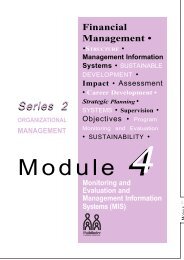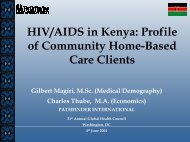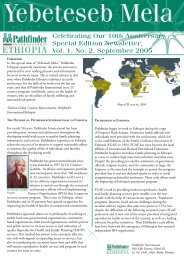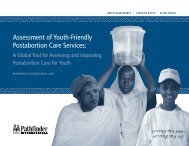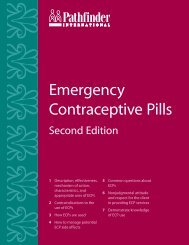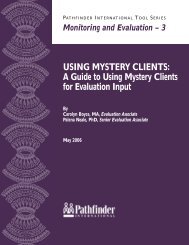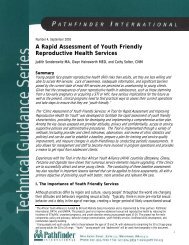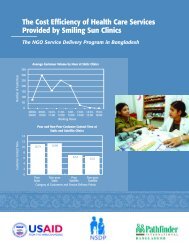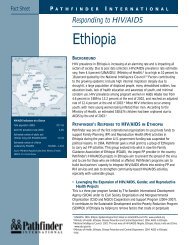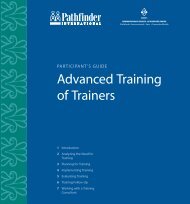reproductive health services for adolescents - Pathfinder International
reproductive health services for adolescents - Pathfinder International
reproductive health services for adolescents - Pathfinder International
Create successful ePaper yourself
Turn your PDF publications into a flip-book with our unique Google optimized e-Paper software.
Module 16/Unit 4<br />
Specific Objective #1: Explain ways that the provider can establish<br />
trust with the adolescent client<br />
CONTENT<br />
Knowledge/Attitudes/Skills<br />
FEELINGS OF THE ADOLESCENT<br />
Understanding the realities and mind-set<br />
of the adolescent client will foster better<br />
communication and responsiveness to<br />
<strong>adolescents</strong>’ needs.<br />
When an adolescent is face-to-face with<br />
a provider (or an adult staff member)<br />
s/he may feel:<br />
• Shy about being in a clinic (especially<br />
<strong>for</strong> RH) and about needing to discuss<br />
personal matters.<br />
• Embarrassed that s/he is seeking RH<br />
care.<br />
• Worried that someone s/he knows<br />
might see her/him and tell the<br />
parents.<br />
• Inadequate to describe what is<br />
concerning her/him and ill-in<strong>for</strong>med<br />
about RH matters in general.<br />
• Anxious that s/he has a serious<br />
condition that has significant<br />
consequences (e.g. STI, pregnancy).<br />
• Intimidated by the medical facility<br />
and/or the many “authority figures” in<br />
the facility.<br />
• Defensive about being the subject of<br />
the discussion or because s/he was<br />
referred against her/his will.<br />
• Resistant to receiving help because<br />
of overall rebelliousness or other<br />
reasons fostering discom<strong>for</strong>t or fear.<br />
Training/Learning Methods<br />
(Time Required)<br />
TRAINER PRESENTATION (10 MIN.)<br />
The trainer should present the content<br />
on the left-hand side of the page.<br />
ROLE PLAY (20 MIN.)<br />
The trainer should:<br />
• Explain that the role play is focused<br />
on the importance of the non-medical<br />
staff of the clinic and how their<br />
actions can impact the adolescent<br />
client’s experience.<br />
• Select 4 Px (or accept volunteers) <strong>for</strong><br />
the role play. Two role plays will be<br />
enacted:<br />
1. An adolescent client and an<br />
insensitive receptionist. The<br />
adolescent attempts to make sure<br />
s/he is in the right place, asks<br />
what to do, inquires about<br />
procedures, etc. (and is very<br />
anxious and uncom<strong>for</strong>table). The<br />
receptionist is busy, over-worked,<br />
believes <strong>adolescents</strong> should not<br />
seek RH care, and is indifferent to<br />
the adolescent’s needs and<br />
sensitivities.<br />
2. An adolescent client and a<br />
trained, sensitive receptionist.<br />
The actors per<strong>for</strong>m the same<br />
scenario as above, but the<br />
receptionist is understanding and<br />
wants to help make the overall<br />
clinical interaction a positive and<br />
effective experience.<br />
<strong>Pathfinder</strong> <strong>International</strong><br />
46<br />
Adolescent Curriculum


